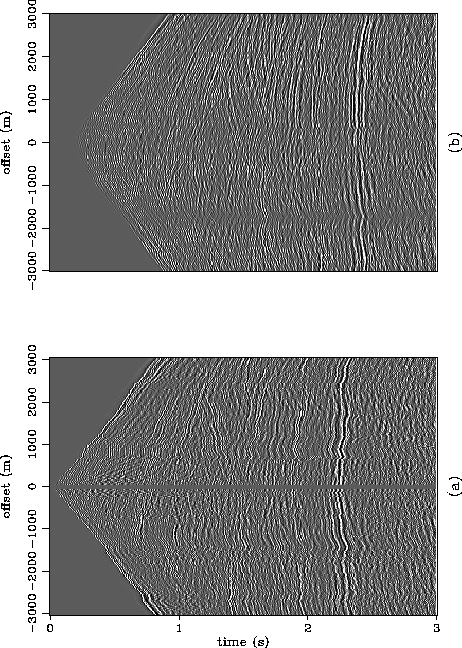




Next: Layer-stripping depth migration
Up: Overview of the dissertation
Previous: Wave-equation datuming
In Chapter ![[*]](http://sepwww.stanford.edu/latex2html/cross_ref_motif.gif) , I apply the Kirchhoff datuming operator to land data
to help ameliorate the effects of rugged topography.
I compare the results of wave-equation datuming to statics and show that
redatuming and regridding with the Kirchhoff datuming
operator results in a superior stacked section and migrated image.
, I apply the Kirchhoff datuming operator to land data
to help ameliorate the effects of rugged topography.
I compare the results of wave-equation datuming to statics and show that
redatuming and regridding with the Kirchhoff datuming
operator results in a superior stacked section and migrated image.
Seismic imaging algorithms are generally applied
to data which is redatumed to a planar surface. In regions of mild topography
where the near-surface velocity is much slower than the subsurface velocity,
a static shift is adequate for the transformation. However, when the
necessary shift increases in magnitude and when the near surface velocity is
comparable to the subsurface velocity, the static approximation becomes
inadequate. Under these circumstances, a static shift distorts the wavefield
and degrades the velocity analysis and imaging.
In this case it is necessary to propagate the wavefield numerically
to some level datum. This wave-equation datuming process may be used to
``flood'' the
topography by filling it with a replacement velocity and upward continuing the
data through it.
Unlike redatuming with static shifts,
wave-equation redatuming removes the distortions caused by
topography in a manner consistent with wavefield propagation.
This insures that subsequent processing steps which assume hyperbolic
form, or even more complicated trajectories consistent with wave
propagation, can be accurately applied.
For example, Figure ![[*]](http://sepwww.stanford.edu/latex2html/cross_ref_motif.gif) shows a shot gather from the Canadian
foothills before and after wave-equation datuming. After
wave-equation datuming the distorting effects of the
topography are removed and the reflection events have
laterally continuous trajectories consistent with wave propagation.
The datuming operation also serves to regrid the data onto a
uniformly sampled output mesh, fill in the shot gap, and
attenuate steep-dip noise.
shows a shot gather from the Canadian
foothills before and after wave-equation datuming. After
wave-equation datuming the distorting effects of the
topography are removed and the reflection events have
laterally continuous trajectories consistent with wave propagation.
The datuming operation also serves to regrid the data onto a
uniformly sampled output mesh, fill in the shot gap, and
attenuate steep-dip noise.
regsup.55
Figure 1 Shot gather before and after wave-equation datuming
(a) A shot gather from the Canadian foothills showing statics from
rugged topography and near-surface effects.
(b) Upward continuation with wave-equation datuming removes the
distortions due to topography and fills in the shot gap. Movie.
![[*]](http://sepwww.stanford.edu/latex2html/movie.gif)






Next: Layer-stripping depth migration
Up: Overview of the dissertation
Previous: Wave-equation datuming
Stanford Exploration Project
2/12/2001
![[*]](http://sepwww.stanford.edu/latex2html/cross_ref_motif.gif) , I apply the Kirchhoff datuming operator to land data
to help ameliorate the effects of rugged topography.
I compare the results of wave-equation datuming to statics and show that
redatuming and regridding with the Kirchhoff datuming
operator results in a superior stacked section and migrated image.
, I apply the Kirchhoff datuming operator to land data
to help ameliorate the effects of rugged topography.
I compare the results of wave-equation datuming to statics and show that
redatuming and regridding with the Kirchhoff datuming
operator results in a superior stacked section and migrated image.

![[*]](http://sepwww.stanford.edu/latex2html/movie.gif)